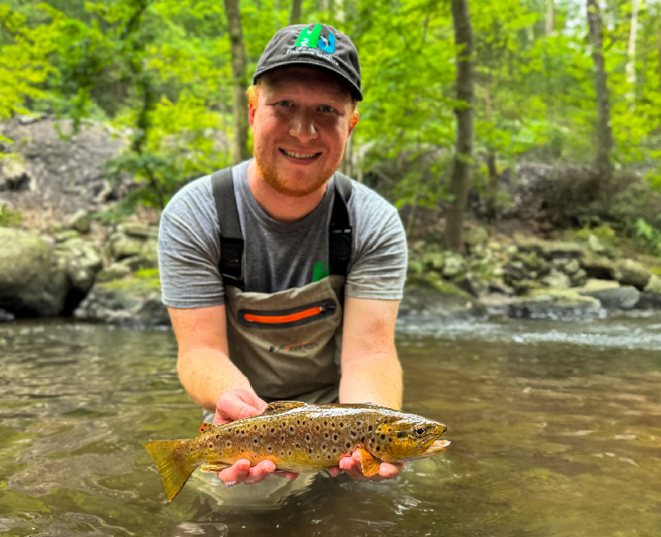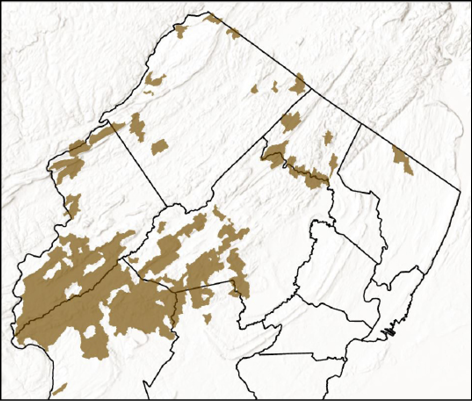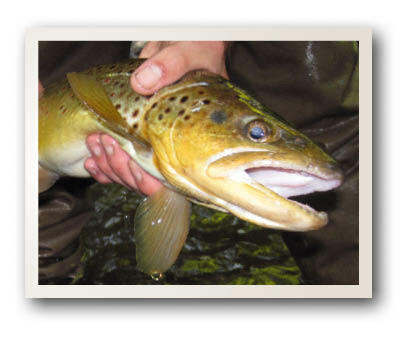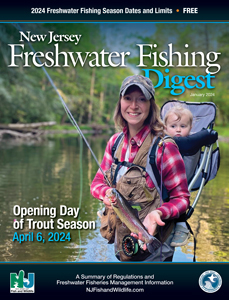Wild Browns Abound

Fisheries Biologist Justin Rozema displaying a colorful catch from the Wild Brown Trout Enhancement section of the Pequannock River. Photo by Maria Berezin-Dowling/NJDEP Fish & Wildlife.
By Shawn Crouse, Freshwater Fisheries Chief
For many anglers, trout fishing revolves around a stocking schedule and weekly replenishments, but for those who have done their homework, angling for wild Brown Trout can be extremely rewarding. Although NJDEP Fish & Wildlife has been exclusively raising Rainbow Trout in recent years, the number of opportunities to catch Brown Trout in New Jersey may surprise you, but they can be trickier to find and catch than their stocked counterparts. Keep in mind some of our most exhilarating fishing experiences are further off the beaten path, waiting to be discovered. Although the wild Brown Trout angling community tends to keep their secret fishing spots close to the vest, we hear (from anglers) and see (through electrofishing surveys) enough places that produce and hold quality fish, and it becomes obvious that the opportunities are out there. We would like to update you on the current management of wild Brown Trout, to point anglers towards the extensive number of waters in which they are found, and to dispel the myth that wild trout are too small to be of interest. It’s time to get the word out about wild Brown Trout in New Jersey!
First Introductions:
First introduced to New Jersey in 1908, Brown Trout (originally from Europe) were experimentally stocked into the South Branch of the Raritan River and the Millstone River from fish obtained from Seth Greene’s hatchery in Caledonia, NY. Due to the success of these early stockings and much interest from anglers, the State’s first Fish Hatchery was built in Hackettstown in 1912, and production of fingerling Brook Trout began. One year later, Rainbow and Brown Trout were added to hatchery production. In 1914, the hatchery began rearing catchable size of all three species for liberation statewide. By 1932, production had risen to a little over half a million trout, similar to the baseline allocation of 570,000 stocked trout of today. The business of raising trout was shifted to the Pequest Trout Hatchery, completed in 1982, with its first trout stocked in 1983. New Jersey’s 2023 Freshwater Fishing Digest featured an extensive article titled, “Pequest Trout Hatchery Celebrates 40 Years.” It chronicled the achievements of the program as well as the challenges faced that led to the difficult decision to discontinue the raising and stocking of Brown and Brook Trout since 2015.
Today:
We are aware that much of the angling public would like to see Brown Trout reintroduced into NJDEP Fish & Wildlife’s stocking program. The decision to produce Rainbow Trout only has not been an easy one, but it was done to maintain the consistency of 570,000 trout produced each spring, in addition to the 25,000 annually stocked during our strong fall and winter programs.
The legacy of Brown Trout stocking remains, as over the last century, select stocked trout naturally spawned in the wild. Their offspring reproduced and the population became self-sustainable. Over generations they have become naturalized in the majority of rivers and streams throughout the northern portion of the state that have suitable habitat and water temperature (see map).

Current distribution map of watersheds containing wild Brown Trout in New Jersey.
In fact, high-quality waters that support reproducing trout are classified as Trout Production. These waters are incorporated into the NJ Department of Environmental Protection’s Surface Water Quality Standards, providing regulatory protection to our most valuable waterways.
In Relation to Brook Trout:
New Jersey DEP Fish & Wildlife’s mission is to protect and manage the State’s wildlife resources to maximize their long-term biological, recreational, and economic values for all New Jerseyans. Responsible fisheries management requires not only defining clear management strategies, but also conveying them to the angling public. The management of Brown Trout in New Jersey is complicated. Wild Brown Trout are widely valued by many anglers, as they are beautiful, strong, and difficult to fool. They also are of great importance as biological indicators of stream health. At the same time, wild Brown Trout pose a significant threat to native Brook Trout when found together. In one concise statement that we have come to use when discussing wild Brown Trout… “We like them, just not everywhere.” Everywhere, refers to being found in the same waters as wild Brook Trout.
Wild Young-of-the-Year (YOY) Brook Trout (top) and wild YOY Brown Trout (bottom).

A difficult dilemma arises when choosing to manage one species over another. Wild trout anglers generally value ALL trout species and typically practice strict catch-and-release. As anglers, we are taught to go to great lengths to minimize handling. Although mandatory release of all Brook Trout within the Brook Trout Conservation Zone (all waters west of Routes 202 and 287) is the law of the land, this is not true for other wild trout species. Wild Brown and Rainbow Trout may be legally harvested in all waters except our state’s two Catch and Release Areas: a 4.2-mile section of the Big Flat/Flat Brook (from Route 206 bridge downstream to the Roy Bridge on Mountain Road) and the 2.2-mile stretch of the South Branch of the Raritan River through the Ken Lockwood Gorge WMA.
From a conservation of native species perspective, Brown Trout are a threat to Brook Trout and in some waters, their release can be detrimental. In Wild Trout Streams managed as Native Brook Trout Streams, anglers are allowed to harvest up to two Brown and/or Rainbow Trout per day, with no minimum size. This management strategy allows anglers to contribute towards NJDEP Fish & Wildlife’s Brook Trout conservation goals by reducing wild Brown and/or Rainbow Trout in select Brook Trout waters. In the absence of Brook Trout, Browns are often the recreational species most valued by fisheries managers and for good reason.
Size and Growth Potential:
Unfortunately, many NJ anglers believe that trout measuring 10 to 12 inches in length are only obtainable when delivered by stocking truck and caught within feet of a stocking point. Anglers may not be aware that New Jersey has the water quality, habitat, and forage to support wild trout, and even those that do, may not realize they grow beyond the expected 7 or 8 inches. In fact, wild Browns, greater than 10 inches, can be found in over 60 individual streams across 7 counties, throughout the northwestern hills of New Jersey! In fact, when NJDEP Fish & Wildlife biologists conduct electrofishing surveys, we are not surprised to encounter quality wild Browns. Surveys typically consist of a standard 150-meter (164 yards) section, used to represent each stream. When developing the latest set of regulations, we found that 20 of the 30 wild Brown Trout streams managed under the Wild Trout Streams regulations, had multiple Browns over 12.5 inches, and 8 of these streams had individuals over 16 inches! Exceptional individuals can surpass the 20-inch mark, making for an unforgettable day on the water.

Two beautiful wild Brown Trout collected by hourly Biologist Luke Diglio Ph.D. (left) and Freshwater Fisheries Chief Shawn Crouse (right) during field research.
Many of these waters offer solitude and a chance to connect with nature. Keep in mind that many of the streams mentioned here are what most anglers would consider to be on the small side, but they still hold good-sized fish. Now imagine the growth potential in some of the larger streams and rivers mentioned below.
Prime Fishing Destinations:
New Jersey boasts several scenic locations offering fantastic wild Brown Trout fishing opportunities. The South Branch of the Raritan River is probably the state’s best Brown Trout fishery. Nearly every tributary from Mount Olive to High Bridge produces wild Browns. Due to its excellent trout habitat, it’s important to be aware that the South Branch has several different regulation sets. The section from the Budd Lake dam downstream to the dam just above Flanders-Drakestown Road is managed as a Native Brook Trout Stream and Browns should be kept out of this area. The next section is ripe with big wild Browns from Flanders-Drakestown Road downstream to the small dam above Schooley’s Mountain Road (Route 517) in Long Valley and is managed as a Wild Trout Stream with multiple trout species present. Moving downstream, the South Branch is regulated as a Trout Stocked Stream AND Wild Brown Trout Managed water, with its own regulations that include the use of bait. This section continues quite a long way, down to the Lake Solitude Dam in High Bridge (excluding the Ken Lockwood Gorge Catch and Release Area, which is one of the most picturesque places to fish in the state). The bottom line is that the South Branch is loaded with wild Brown Trout from Flanders-Drakestown Road down through the Ken Lockwood Gorge and has distinct regulations for all types of anglers.

Large wild Brown from the South Branch of the Raritan River in Long Valley.
Farther north, the Pequannock River between Oak Ridge Reservoir and Charlottesburg Reservoir (managed by Newark Watershed) provides a fantastic opportunity for consistent action throughout the summer months due to coldwater releases from Oak Ridge Reservoir. If you’re looking for some of the biggest Brown Trout in the state, you might want to explore the lower section of the Wanaque River, below Wanaque Reservoir. Although low in number, the Wanaque often produces wild Brown Trout over 20 inches.
One of the most scenic locations, with its large waterfalls and deep plunge pools, Van Campens Brook within the Delaware Water Gap National Recreation Area is another great option. Dunnfield Creek in Worthington State Forest can be a bit treacherous and has an adjacent hiking path that is heavily used but is a neat place to fish if you haven’t tried it. The overlapping Brook and Brown Trout populations also give you a chance to catch a hybrid Tiger Trout.
The Musconetcong River and many of its tributaries, located in Warren, Hunterdon, and Morris Counties, is a renowned trout fishery, with stretches of water that provide excellent habitat. While the staple of “The Musky” may be its Rainbow Trout fishery, as it is the longest stocked river in the state receiving almost 54,000 each spring and over 2,800 each fall, many of its tributaries produce beautiful wild Browns. It is no surprise to catch one in the mainstem river.
Additional streams that are often overlooked for their wild Brown Trout potential include: Warren County’s Lopatcong and Pohatcong Creeks, Hunterdon County’s Capoolong, Mulhockaway, and Spruce Run Creeks, and Morris/Somerset County’s Black/Lamington River. These waters offer wild Browns alongside stocked Rainbows. They are also a little bit larger than most Wild Trout Streams and are more fishable.
Best Times to Fish:
Timing is crucial when it comes to targeting wild Brown Trout in New Jersey. The spring and fall seasons are particularly productive, with cooler water temperatures and the presence of aquatic insect hatches that Brown Trout eagerly feed on. During the spring, wild trout become more active and aggressive, providing exciting angling opportunities. Late summer months, with the warmest water temperatures, are a time that many wild trout anglers give trout a break, as warm waters are stressful for trout. As foliage changes color in the fall, trout become more territorial and feed voraciously to prepare for the winter months.
Wild Brown Trout are typically very skittish in crystal clear water, so anglers may want to try just after a slight rain when the water is higher and slightly off-color. Stealthy approaches, accurate casting, and reading the water are skills that can greatly enhance your success rate. Some key aspects of reading the water include: recognizing areas with suitable cover like rocks, fallen trees, or overhanging vegetation where trout can hide; understanding water flow patterns; and identifying seams and eddies that trap food. Deeper pools are known to hold larger wild Browns over 20 inches, however, these fish are wearier than their hatchery-raised counterparts.
Effective Techniques:
Successful wild Brown Trout fishing in New Jersey often involves either light spinning tackle, fly fishing, or a combination of both.
Spin anglers can utilize small spoons and spinners (less than ¼ ounce), plugs (less than 4 inches), or soft plastic baits to entice these fish. Try casting these upstream at a 45-degree angle and allowing them to travel across the current back to you. If you enjoy fishing with bait, there are multiple Brown Trout streams in which fishing with bait is permitted. Five of the waters managed as Trout-Stocked Streams — Wild Brown Trout Managed, include Hakihohake Creek, Lopatcong Creek, Pophandusing Creek, Raritan River S/Br., and the Saddle River. Drifting with a nightcrawler can produce many large Browns in a surprisingly short period of time when allowed to bounce naturally along the bottom.
Fly anglers can use a variety of nymphs, dry flies, and streamers that imitate the local aquatic insects and small fish. Popular fly patterns such as Pheasant Tails, Woolly Buggers, and Elk Hair Caddis are effective in enticing Brown Trout to strike. One effective technique is to ‘swing’ a streamer through the deepest pools by casting upstream, letting the fly sink, and letting the current drag it across the pool. Fishing with a “dry-dropper” setup, consisting of a small nymph tied about 6–18" below a larger dry fly, is a popular rig for anglers seeking Brown Trout in smaller, shallower tributaries and locations where they are more likely to spook. Also, try standing downstream and casting upstream into pools to keep fish from being able to see you.
Wild Trout Regulations:
New Jersey’s statewide general trout fishing regulations incorporate a minimum legal size of 9 inches, therefore affording protection to all wild trout species under 9 inches. The Fish and Game Council adopted revised Wild Trout Stream regulations in 2018, defined as either 1) Native Brook Trout Streams, 2) Multiple wild trout species present (Brook, Brown and/or Rainbow Trout), and 3) Wild Brown Trout Enhancement Streams, in part to help anglers better recognize the different kinds of wild trout stream fishing opportunities available in specific waters and to help Fish and Wildlife achieve appropriate stream-specific management goals. In other words, Brown Trout management strategies differ from one stream or river to the next - in some waters they are favored and in others they are not. Trout fishing regulations can be found in General Trout Information.
Proper Handling:
Handling and releasing a trout properly is essential for the fish's survival. When fishing waters regulated as Wild Trout Streams and Catch and Release Areas, barbless hooks, with no more than a total of 3 hook points must be used. Wet your hands before handling the fish to protect its delicate mucus layer. Hold the trout gently but firmly, supporting its body horizontally to avoid injury. Avoid squeezing or touching its gills. If the fish is deeply hooked, don't force the hook out- instead, cut the line as close to the hook as possible. To release the trout, gently place it back into the water, allowing it to swim away at its own pace. Ensure it has fully recovered before letting go and avoid dropping it from a height or dragging it across rocks. By following these guidelines, you'll help conserve trout populations and maintain healthy aquatic ecosystems.
In Closing:
We are anglers. We understand that for many, variety is king — different species, habitats, and techniques. Some days we want to fish with bait, some days we prefer lures. At times we want to show family and friends a good time putting them on fish and some days we just need to sneak away and fish in solitude. We can be marveled by the latest and greatest technology to get the edge, or we can be happy to sit on the bank with a nightcrawler. The beauty of fishing is that it is whatever you want it to be; fast paced action or peace and quiet; reliable stockings or wild discoveries.
Wild Brown Trout provide a different experience than fishing for stocked trout. Some anglers perceive it as more challenging and more rewarding. We wanted to provide information for those wanting to try something new and to make you aware of the many opportunities to fish for Brown Trout in New Jersey. Brown Trout waters span a large geographic area and Browns larger than stocking size (>10.5 inches) are not uncommon. Wild Browns can be very skittish and finicky. You will have to modify your techniques. You might not have as much action. In many cases you will have to venture a little deeper into the woods to find these hidden treasures.
So, gear up, cast your line, and immerse yourself in the wonders of wild trout fishing in New Jersey, where Wild Browns Abound!

